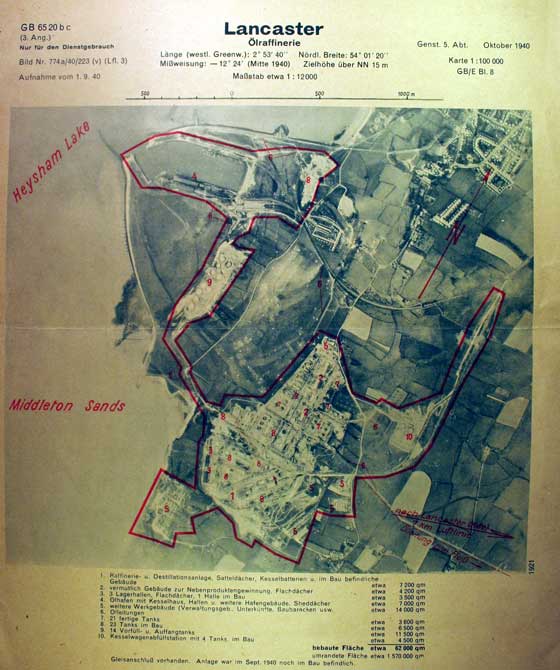
| Top of page |
| Back |
The word ‘Trimpell’ was an amalgamation of Trinidad Leasing, Imperial Chemical Industries (ICI) and Shell, and after making aviation fuel for the Air Ministry the refinery was to produce explosives, nitric acid and fertiliser. The main site at Heysham was funded by the Ministry of Aircraft Production. The Ministry of Supply funded a Nitric Acid and Ammonium Nitrate plant for explosive purposes which was also run by Trimpell.
The site was set up in 1939 as the Heysham Aviation Fuel Works to supplement the North American supplies of aviation fuel for the RAF. Using coke brought in from the Durham coal field together with imported gas oil, ICI produced the base petrol and ammonia while Shell produced iso-octane to boost the base petrol from 87 octane to 100 octane standard. Shell had found that the use of tetraethyl lead and hydrogen as fuel additives made it possible to suppress engine knock and to boost aircraft engine performance.
The plant at Heysham, together with those at Stanlow and Billingham produced iso-octane additives required to raise 87 octane fuel to 100 octane rating. Initially, the limited size of the 100 octane fuel stockpile required strict rationing until supplies could be increased to meet requirements and the 100 octane fuel was dyed green to distinguish it from the 87 octane fuel which was blue. Bulk supply contracts for higher octane fuel were placed by the Air Ministry and it was put into widespread use in the RAF in March 1940 when Spitfires' Rolls Royce Merlin engines were converted to use the 100 octane fuel.
By May 1940, reconnaissance Spitfires had begun flying combat missions using the 100 octane fuel. By 31 July 1940, there were 384 Spitfires serving in 19 squadrons using the 100 octane fuel. A German aerial reconnaissance photograph, dated October 1940 and marked 'only for internal use', showed the oil refinery with some areas of the plant such as the boiler house, storage tanks (including those under construction), and flat-roofed warehouses being labelled on the photograph. In 1941 the refinery was bombed: The Trimpell works was under construction when it came to the notice of the German air force. On 1st September 1940 the German Luftwaffe took an aeriel reconnaissance photograph of Heysham Harbour and surrounding area. They highlighted important targets including the new oil installations associated with the Trimpell Refinery.

| Top of page |